maintenance YAMAHA XV535 2000 User Guide
[x] Cancel search | Manufacturer: YAMAHA, Model Year: 2000, Model line: XV535, Model: YAMAHA XV535 2000Pages: 87, PDF Size: 17.84 MB
Page 46 of 87
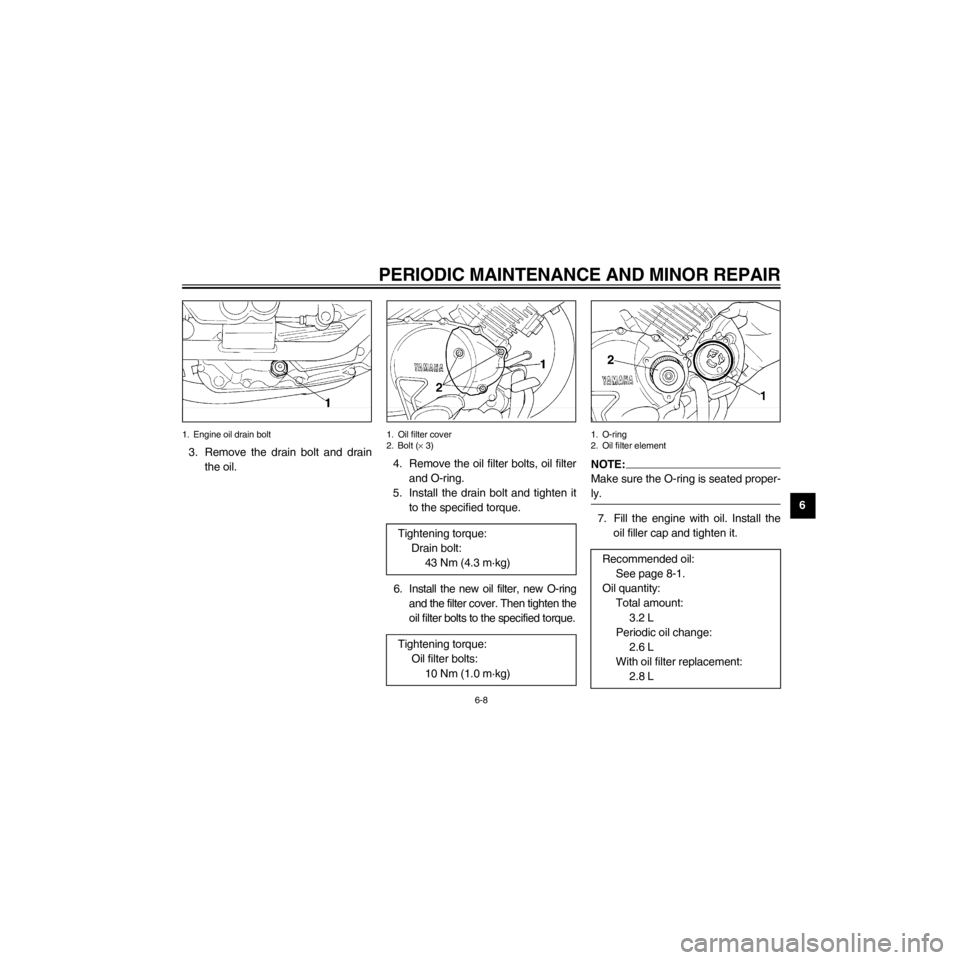
R
6-8
PERIODIC MAINTENANCE AND MINOR REPAIR
/Net/layout8/layout_G2/work/Imai_work/OM-PS/AA9149_XV535-E6/English/E-6.frame
1. Engine oil drain bolt
3. Remove the drain bolt and drain
the oil.
1. Oil filter cover
2. Bolt (´ 3)
4. Remove the oil filter bolts, oil filter
and O-ring.
5. Install the drain bolt and tighten it
to the specified torque.
6. Install the new oil filter, new O-ring
and the filter cover. Then tighten the
oil filter bolts to the specified torque. Tightening torque:
Drain bolt:
43 Nm (4.3 mákg)
Tightening torque:
Oil filter bolts:
10 Nm (1.0 mákg)
1. O-ring
2. Oil filter element
NOTE:
Make sure the O-ring is seated proper-
ly.
7. Fill the engine with oil. Install the
oil filler cap and tighten it.
Recommended oil:
See page 8-1.
Oil quantity:
Total amount:
3.2 L
Periodic oil change:
2.6 L
With oil filter replacement:
2.8 L
Page 47 of 87
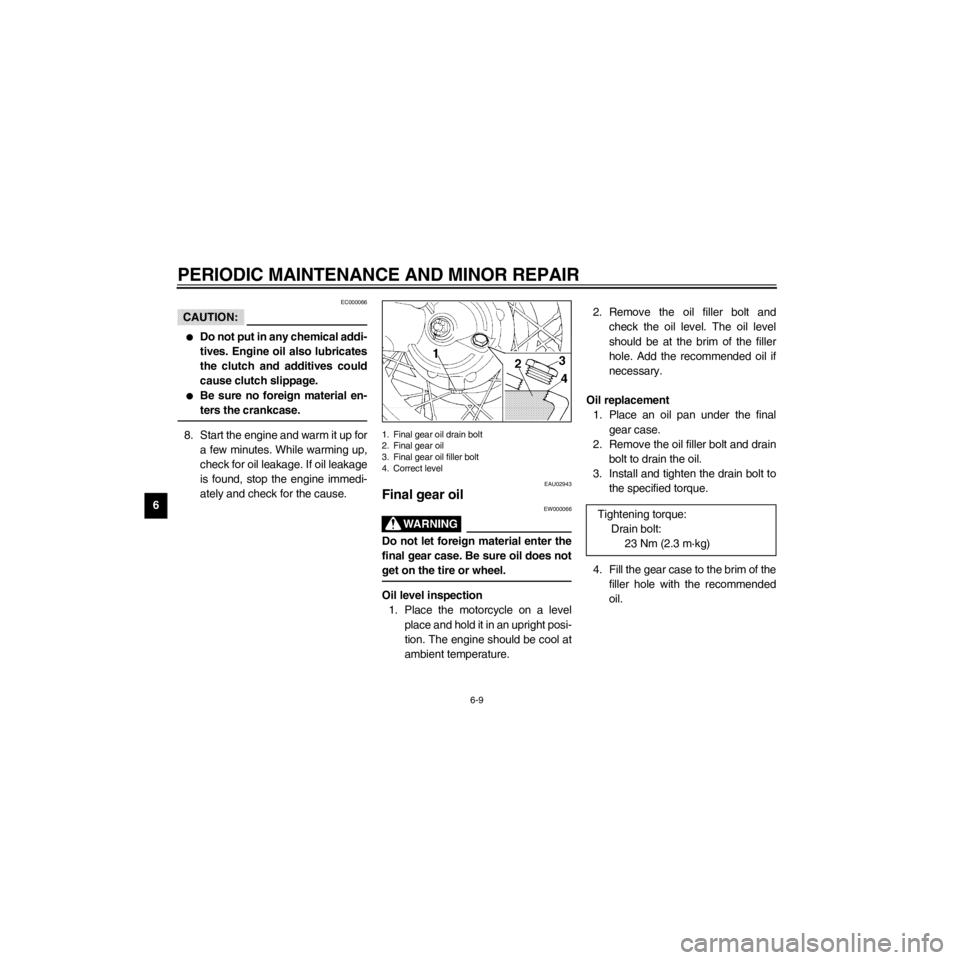
L
6-9
PERIODIC MAINTENANCE AND MINOR REPAIR
/Net/layout8/layout_G2/work/Imai_work/OM-PS/AA9149_XV535-E6/English/E-6.frame
EC000066
CAUTION:
lDo not put in any chemical addi-
tives. Engine oil also lubricates
the clutch and additives could
cause clutch slippage.
lBe sure no foreign material en-
ters the crankcase.
8. Start the engine and warm it up for
a few minutes. While warming up,
check for oil leakage. If oil leakage
is found, stop the engine immedi-
ately and check for the cause.
1. Final gear oil drain bolt
2. Final gear oil
3. Final gear oil filler bolt
4. Correct level
EAU02943
Final gear oil
EW000066
Do not let foreign material enter the
final gear case. Be sure oil does not
get on the tire or wheel.
Oil level inspection
1. Place the motorcycle on a level
place and hold it in an upright posi-
tion. The engine should be cool at
ambient temperature.2. Remove the oil filler bolt and
check the oil level. The oil level
should be at the brim of the filler
hole. Add the recommended oil if
necessary.
Oil replacement
1. Place an oil pan under the final
gear case.
2. Remove the oil filler bolt and drain
bolt to drain the oil.
3. Install and tighten the drain bolt to
the specified torque.
4. Fill the gear case to the brim of the
filler hole with the recommended
oil. Tightening torque:
Drain bolt:
23 Nm (2.3 mákg)
Page 48 of 87
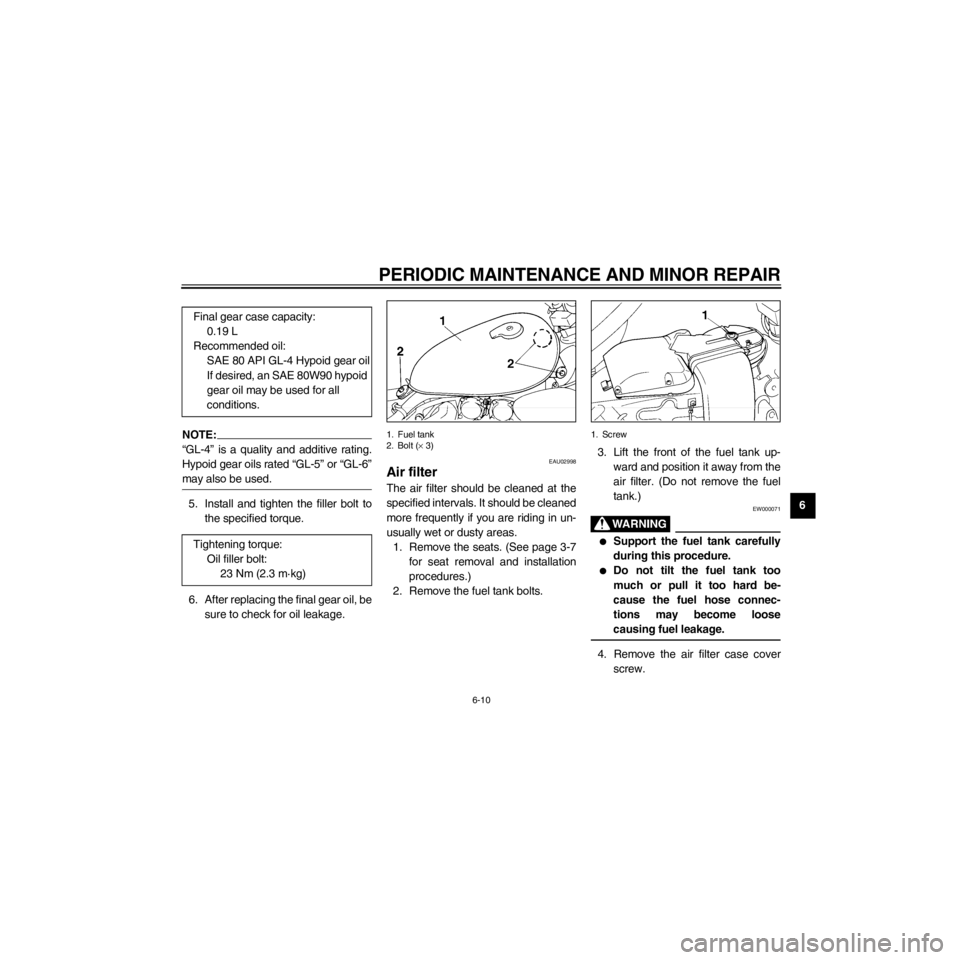
R
6-10
PERIODIC MAINTENANCE AND MINOR REPAIR
/Net/layout8/layout_G2/work/Imai_work/OM-PS/AA9149_XV535-E6/English/E-6.frame
NOTE:
ÒGL-4Ó is a quality and additive rating.
Hypoid gear oils rated ÒGL-5Ó or ÒGL-6Ó
may also be used.
5. Install and tighten the filler bolt to
the specified torque.
6. After replacing the final gear oil, be
sure to check for oil leakage. Final gear case capacity:
0.19 L
Recommended oil:
SAE 80 API GL-4 Hypoid gear oil
If desired, an SAE 80W90 hypoid
gear oil may be used for all
conditions.
Tightening torque:
Oil filler bolt:
23 Nm (2.3 mákg)
1. Fuel tank
2. Bolt (´ 3)
EAU02998
Air filter
The air filter should be cleaned at the
specified intervals. It should be cleaned
more frequently if you are riding in un-
usually wet or dusty areas.
1. Remove the seats. (See page 3-7
for seat removal and installation
procedures.)
2. Remove the fuel tank bolts.
1. Screw
3. Lift the front of the fuel tank up-
ward and position it away from the
air filter. (Do not remove the fuel
tank.)
EW000071
lSupport the fuel tank carefully
during this procedure.
lDo not tilt the fuel tank too
much or pull it too hard be-
cause the fuel hose connec-
tions may become loose
causing fuel leakage.
4. Remove the air filter case cover
screw.
Page 49 of 87
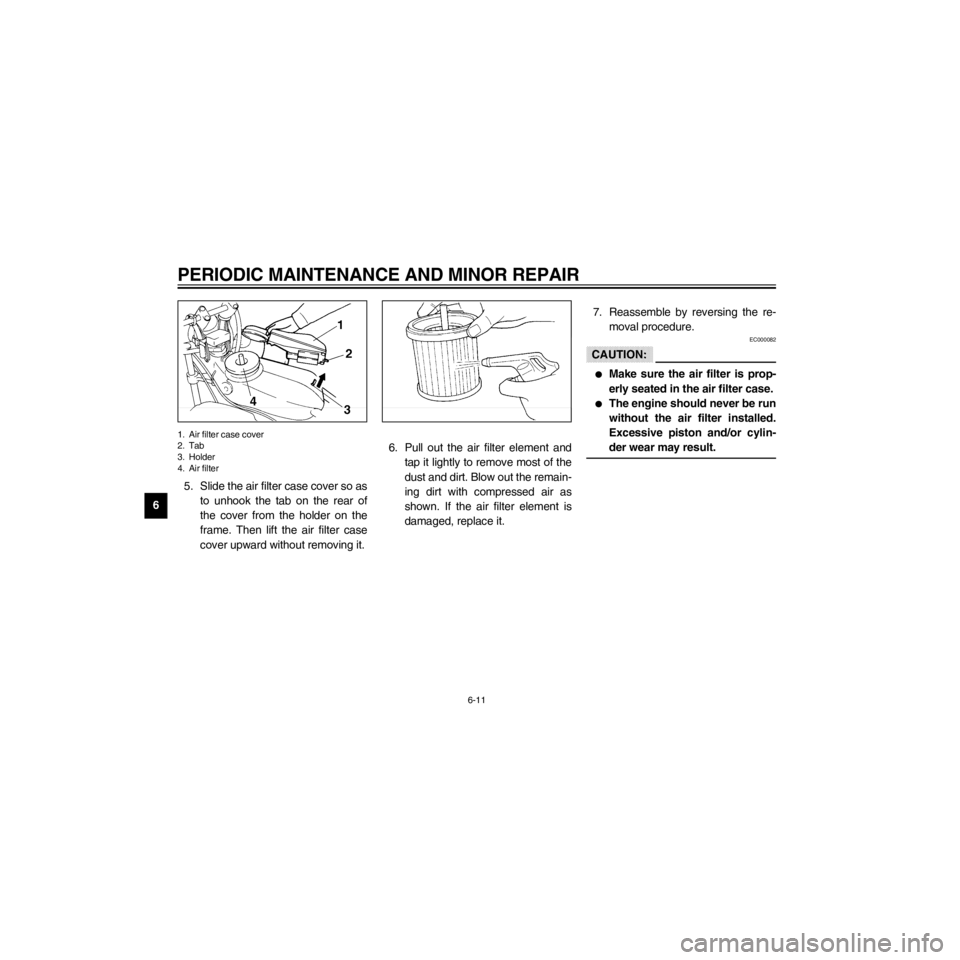
L
6-11
PERIODIC MAINTENANCE AND MINOR REPAIR
/Net/layout8/layout_G2/work/Imai_work/OM-PS/AA9149_XV535-E6/English/E-6.frame
1. Air filter case cover
2. Tab
3. Holder
4. Air filter
5. Slide the air filter case cover so as
to unhook the tab on the rear of
the cover from the holder on the
frame. Then lift the air filter case
cover upward without removing it.
6. Pull out the air filter element and
tap it lightly to remove most of the
dust and dirt. Blow out the remain-
ing dirt with compressed air as
shown. If the air filter element is
damaged, replace it.7. Reassemble by reversing the re-
moval procedure.
EC000082
CAUTION:
lMake sure the air filter is prop-
erly seated in the air filter case.
lThe engine should never be run
without the air filter installed.
Excessive piston and/or cylin-
der wear may result.
Page 50 of 87
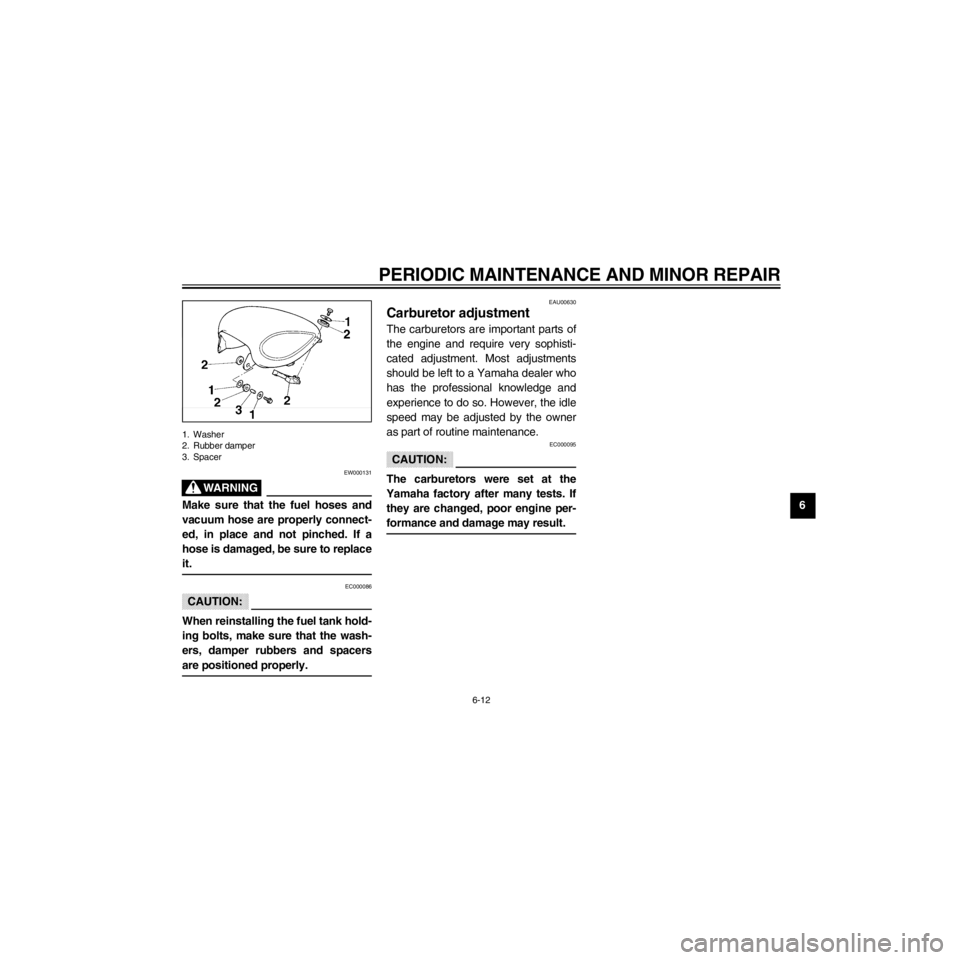
R
6-12
PERIODIC MAINTENANCE AND MINOR REPAIR
/Net/layout8/layout_G2/work/Imai_work/OM-PS/AA9149_XV535-E6/English/E-6.frame
1. Washer
2. Rubber damper
3. Spacer
EW000131
Make sure that the fuel hoses and
vacuum hose are properly connect-
ed, in place and not pinched. If a
hose is damaged, be sure to replace
it.
EC000086
CAUTION:
When reinstalling the fuel tank hold-
ing bolts, make sure that the wash-
ers, damper rubbers and spacers
are positioned properly.
EAU00630
Carburetor adjustment
The carburetors are important parts of
the engine and require very sophisti-
cated adjustment. Most adjustments
should be left to a Yamaha dealer who
has the professional knowledge and
experience to do so. However, the idle
speed may be adjusted by the owner
as part of routine maintenance.
EC000095
CAUTION:
The carburetors were set at the
Yamaha factory after many tests. If
they are changed, poor engine per-
formance and damage may result.
Page 51 of 87
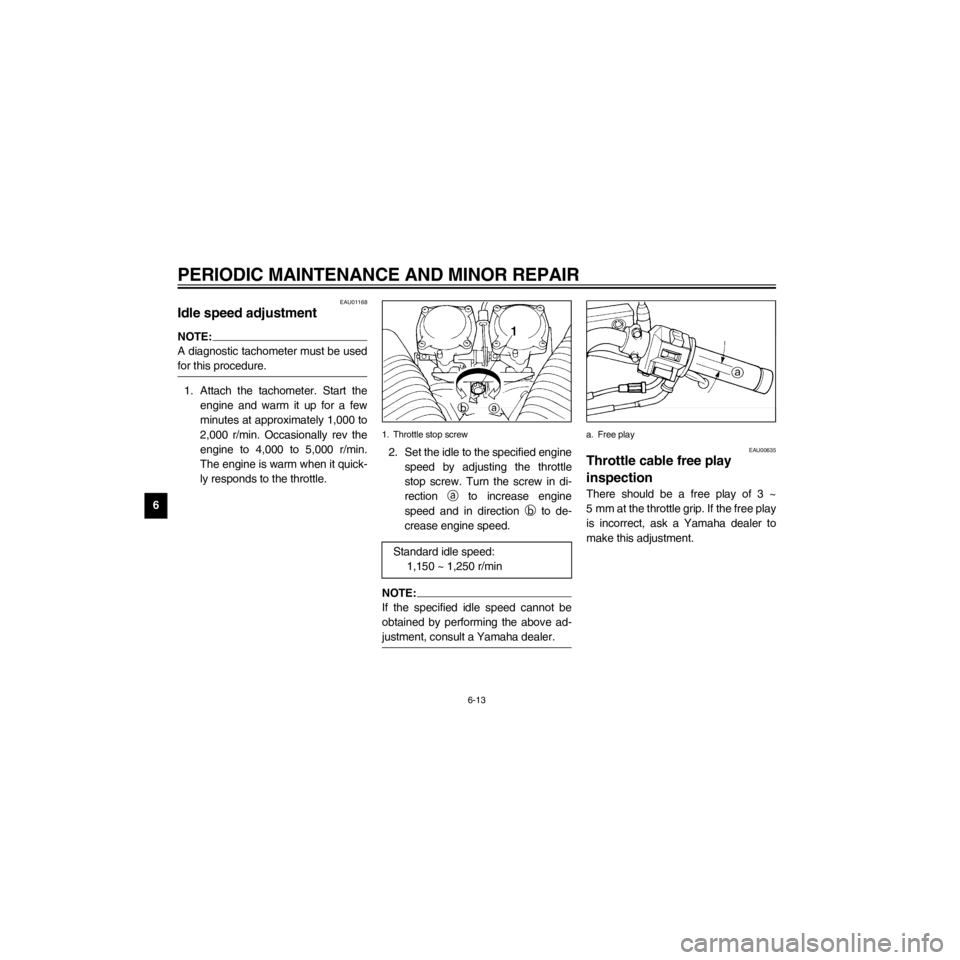
L
6-13
PERIODIC MAINTENANCE AND MINOR REPAIR
/Net/layout8/layout_G2/work/Imai_work/OM-PS/AA9149_XV535-E6/English/E-6.frame
EAU01168
Idle speed adjustment
NOTE:
A diagnostic tachometer must be used
for this procedure.
1. Attach the tachometer. Start the
engine and warm it up for a few
minutes at approximately 1,000 to
2,000 r/min. Occasionally rev the
engine to 4,000 to 5,000 r/min.
The engine is warm when it quick-
ly responds to the throttle.
1. Throttle stop screw
2. Set the idle to the specified engine
speed by adjusting the throttle
stop screw. Turn the screw in di-
rectiona
to increase engine
speed and in direction b
to de-
crease engine speed.
NOTE:
If the specified idle speed cannot be
obtained by performing the above ad-
justment, consult a Yamaha dealer.Standard idle speed:
1,150 ~ 1,250 r/min
a. Free play
EAU00635
Throttle cable free play
inspection
There should be a free play of 3 ~
5 mm at the throttle grip. If the free play
is incorrect, ask a Yamaha dealer to
make this adjustment.
Page 52 of 87
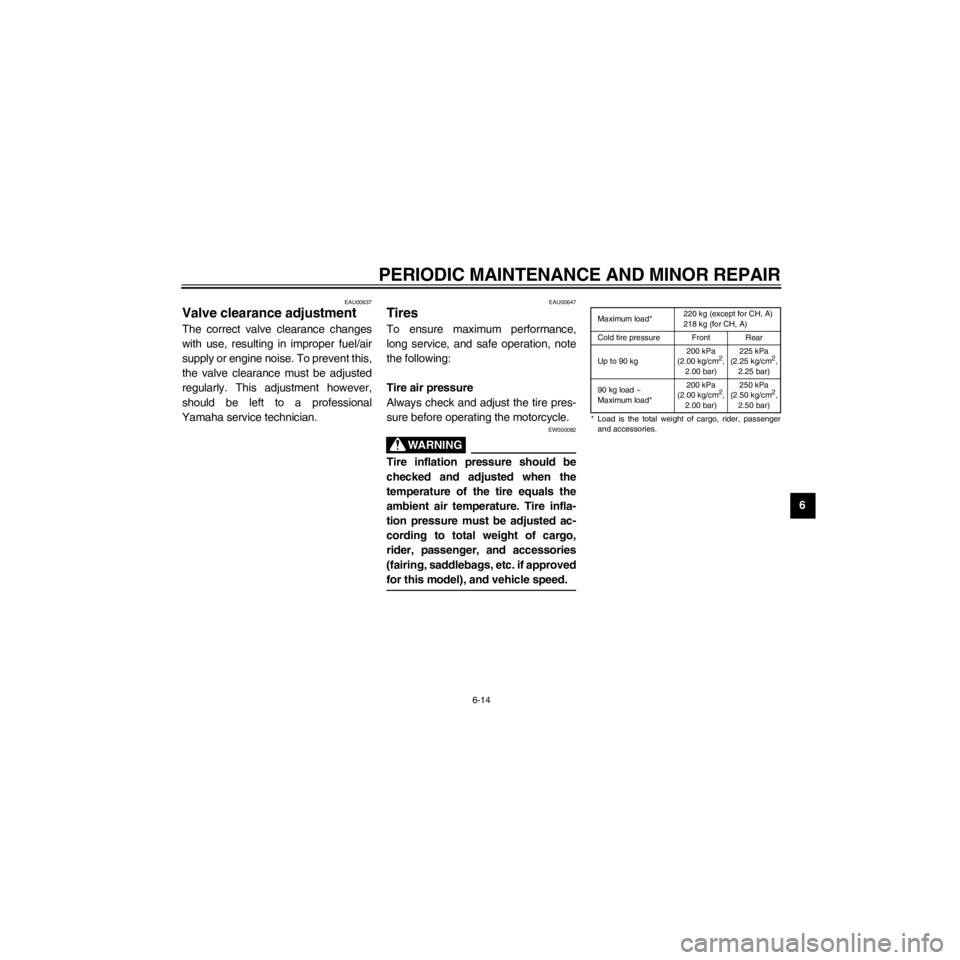
R
6-14
PERIODIC MAINTENANCE AND MINOR REPAIR
/Net/layout8/layout_G2/work/Imai_work/OM-PS/AA9149_XV535-E6/English/E-6.frame
EAU00637
Valve clearance adjustment
The correct valve clearance changes
with use, resulting in improper fuel/air
supply or engine noise. To prevent this,
the valve clearance must be adjusted
regularly. This adjustment however,
should be left to a professional
Yamaha service technician.
EAU00647
Tires
To ensure maximum performance,
long service, and safe operation, note
the following:
Tire air pressure
Always check and adjust the tire pres-
sure before operating the motorcycle.
EW000082
Tire inflation pressure should be
checked and adjusted when the
temperature of the tire equals the
ambient air temperature. Tire infla-
tion pressure must be adjusted ac-
cording to total weight of cargo,
rider, passenger, and accessories
(fairing, saddlebags, etc. if approved
for this model), and vehicle speed.
Maximum load*220 kg (except for CH, A)
218 kg (for CH, A)
Cold tire pressure Front Rear
Up to 90 kg200 kPa
(2.00 kg/cm
2,
2.00 bar)225 kPa
(2.25 kg/cm2,
2.25 bar)
90 kg load ~
Maximum load*200 kPa
(2.00 kg/cm
2,
2.00 bar)250 kPa
(2.50 kg/cm2,
2.50 bar)
* Load is the total weight of cargo, rider, passenger
and accessories.
Page 53 of 87
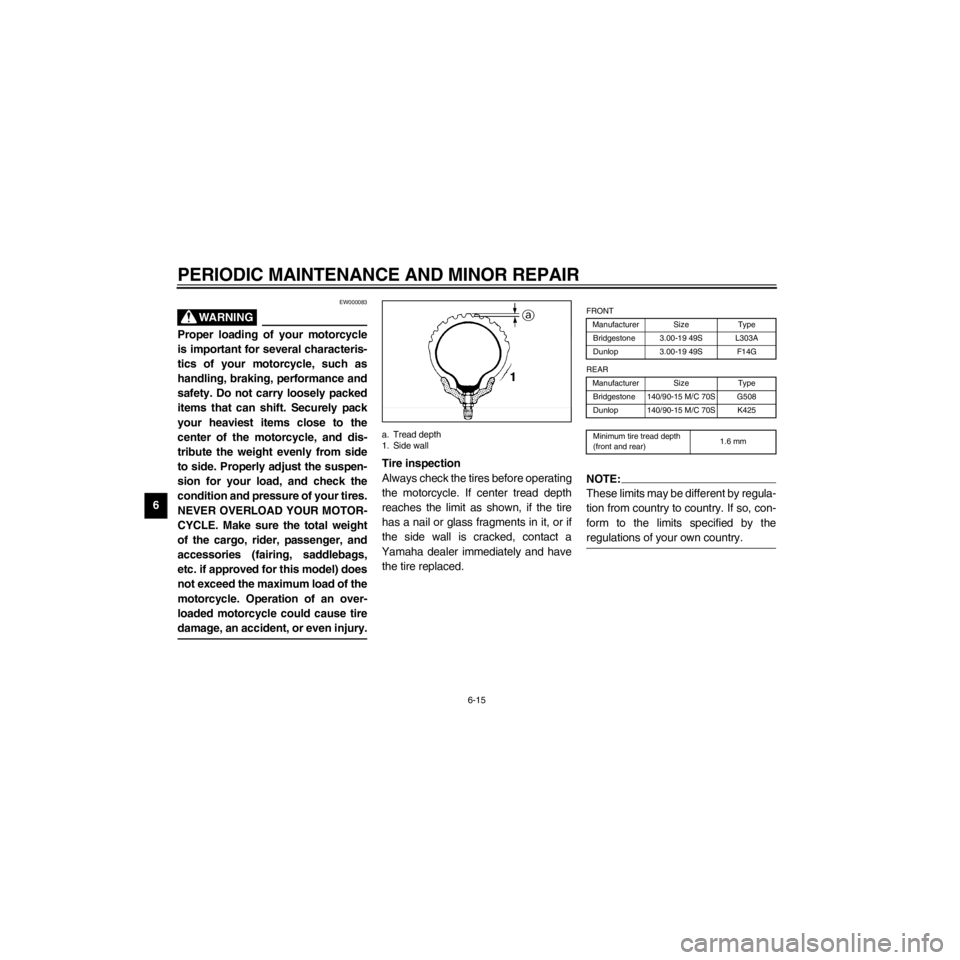
L
6-15
PERIODIC MAINTENANCE AND MINOR REPAIR
/Net/layout8/layout_G2/work/Imai_work/OM-PS/AA9149_XV535-E6/English/E-6.frame
EW000083
Proper loading of your motorcycle
is important for several characteris-
tics of your motorcycle, such as
handling, braking, performance and
safety. Do not carry loosely packed
items that can shift. Securely pack
your heaviest items close to the
center of the motorcycle, and dis-
tribute the weight evenly from side
to side. Properly adjust the suspen-
sion for your load, and check the
condition and pressure of your tires.
NEVER OVERLOAD YOUR MOTOR-
CYCLE. Make sure the total weight
of the cargo, rider, passenger, and
accessories (fairing, saddlebags,
etc. if approved for this model) does
not exceed the maximum load of the
motorcycle. Operation of an over-
loaded motorcycle could cause tire
damage, an accident, or even injury.
a. Tread depth
1. Side wall
Tire inspection
Always check the tires before operating
the motorcycle. If center tread depth
reaches the limit as shown, if the tire
has a nail or glass fragments in it, or if
the side wall is cracked, contact a
Yamaha dealer immediately and have
the tire replaced.
NOTE:
These limits may be different by regula-
tion from country to country. If so, con-
form to the limits specified by the
regulations of your own country.
FRONT
Manufacturer Size Type
Bridgestone 3.00-19 49S L303A
Dunlop 3.00-19 49S F14G
REAR
Manufacturer Size Type
Bridgestone 140/90-15 M/C 70S G508
Dunlop 140/90-15 M/C 70S K425
Minimum tire tread depth
(front and rear)1.6 mm
Page 54 of 87
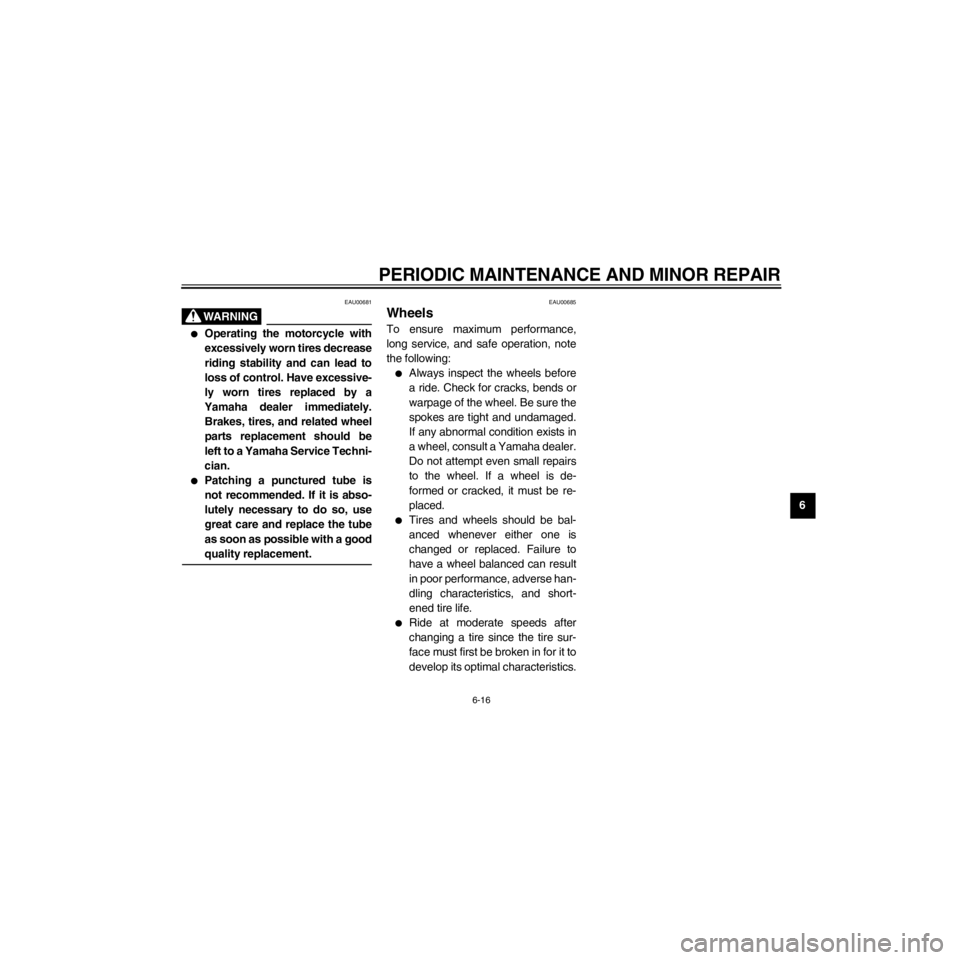
R
6-16
PERIODIC MAINTENANCE AND MINOR REPAIR
/Net/layout8/layout_G2/work/Imai_work/OM-PS/AA9149_XV535-E6/English/E-6.frame
EAU00681
lOperating the motorcycle with
excessively worn tires decrease
riding stability and can lead to
loss of control. Have excessive-
ly worn tires replaced by a
Yamaha dealer immediately.
Brakes, tires, and related wheel
parts replacement should be
left to a Yamaha Service Techni-
cian.
lPatching a punctured tube is
not recommended. If it is abso-
lutely necessary to do so, use
great care and replace the tube
as soon as possible with a good
quality replacement.
EAU00685
Wheels
To ensure maximum performance,
long service, and safe operation, note
the following:
lAlways inspect the wheels before
a ride. Check for cracks, bends or
warpage of the wheel. Be sure the
spokes are tight and undamaged.
If any abnormal condition exists in
a wheel, consult a Yamaha dealer.
Do not attempt even small repairs
to the wheel. If a wheel is de-
formed or cracked, it must be re-
placed.
lTires and wheels should be bal-
anced whenever either one is
changed or replaced. Failure to
have a wheel balanced can result
in poor performance, adverse han-
dling characteristics, and short-
ened tire life.
lRide at moderate speeds after
changing a tire since the tire sur-
face must first be broken in for it to
develop its optimal characteristics.
Page 55 of 87
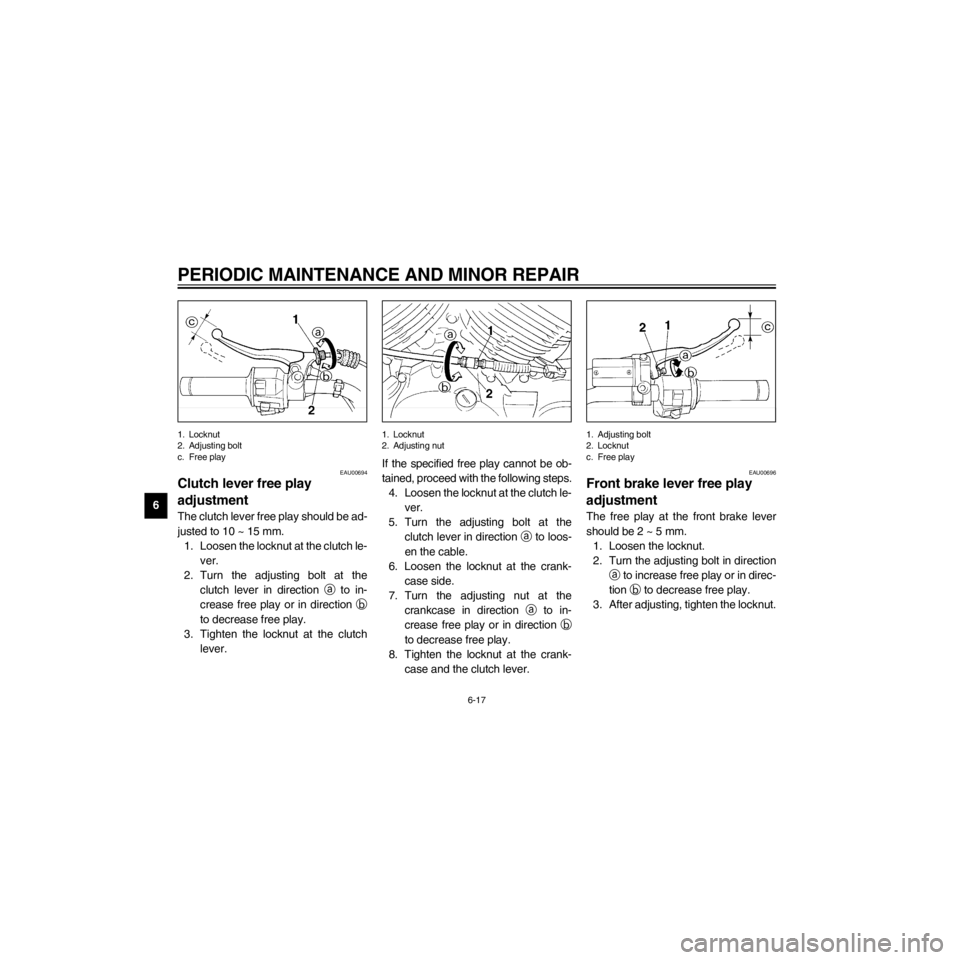
L
6-17
PERIODIC MAINTENANCE AND MINOR REPAIR
/Net/layout8/layout_G2/work/Imai_work/OM-PS/AA9149_XV535-E6/English/E-6.frame
1. Locknut
2. Adjusting bolt
c. Free play
EAU00694
Clutch lever free play
adjustment
The clutch lever free play should be ad-
justed to 10 ~ 15 mm.
1. Loosen the locknut at the clutch le-
ver.
2. Turn the adjusting bolt at the
clutch lever in direction a
to in-
crease free play or in direction b
to decrease free play.
3. Tighten the locknut at the clutch
lever.
1. Locknut
2. Adjusting nut
If the specified free play cannot be ob-
tained, proceed with the following steps.
4. Loosen the locknut at the clutch le-
ver.
5. Turn the adjusting bolt at the
clutch lever in direction a
to loos-
en the cable.
6. Loosen the locknut at the crank-
case side.
7. Turn the adjusting nut at the
crankcase in direction a
to in-
crease free play or in direction b
to decrease free play.
8. Tighten the locknut at the crank-
case and the clutch lever.
1. Adjusting bolt
2. Locknut
c. Free play
EAU00696
Front brake lever free play
adjustment
The free play at the front brake lever
should be 2 ~ 5 mm.
1. Loosen the locknut.
2. Turn the adjusting bolt in direction
a
to increase free play or in direc-
tionb
to decrease free play.
3. After adjusting, tighten the locknut.